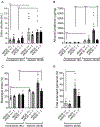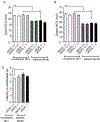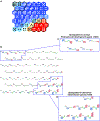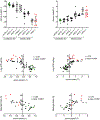Gene expression profiles of diabetic kidney disease and neuropathy in eNOS knockout mice: Predictors of pathology and RAS blockade effects
- PMID: 33788970
- PMCID: PMC10202027
- DOI: 10.1096/fj.202002387R
Gene expression profiles of diabetic kidney disease and neuropathy in eNOS knockout mice: Predictors of pathology and RAS blockade effects
Abstract
Diabetic kidney disease (DKD) and diabetic peripheral neuropathy (DPN) are two common diabetic complications. However, their pathogenesis remains elusive and current therapies are only modestly effective. We evaluated genome-wide expression to identify pathways involved in DKD and DPN progression in db/db eNOS-/- mice receiving renin-angiotensin-aldosterone system (RAS)-blocking drugs to mimic the current standard of care for DKD patients. Diabetes and eNOS deletion worsened DKD, which improved with RAS treatment. Diabetes also induced DPN, which was not affected by eNOS deletion or RAS blockade. Given the multiple factors affecting DKD and the graded differences in disease severity across mouse groups, an automatic data analysis method, SOM, or self-organizing map was used to elucidate glomerular transcriptional changes associated with DKD, whereas pairwise bioinformatic analysis was used for DPN. These analyses revealed that enhanced gene expression in several pro-inflammatory networks and reduced expression of development genes correlated with worsening DKD. Although RAS treatment ameliorated the nephropathy phenotype, it did not alter the more abnormal gene expression changes in kidney. Moreover, RAS exacerbated expression of genes related to inflammation and oxidant generation in peripheral nerves. The graded increase in inflammatory gene expression and decrease in development gene expression with DKD progression underline the potentially important role of these pathways in DKD pathogenesis. Since RAS blockers worsened this gene expression pattern in both DKD and DPN, it may partly explain the inadequate therapeutic efficacy of such blockers.
Keywords: RAS blockade; diabetic kidney disease; diabetic peripheral neuropathy; genome-wide expression; self-organizing map.
© 2021 Federation of American Societies for Experimental Biology.
Conflict of interest statement
Conflict of Interest
The authors have stated explicitly that there are no conflicts of interest in connection with this article.
Figures






Similar articles
-
Fatty acid transport protein-2 regulates glycemic control and diabetic kidney disease progression.JCI Insight. 2020 Aug 6;5(15):e136845. doi: 10.1172/jci.insight.136845. JCI Insight. 2020. PMID: 32614804 Free PMC article.
-
Renin-angiotensin system inhibition reverses the altered triacylglycerol metabolic network in diabetic kidney disease.Metabolomics. 2021 Jul 4;17(7):65. doi: 10.1007/s11306-021-01816-0. Metabolomics. 2021. PMID: 34219205 Free PMC article.
-
MMP-10 is Increased in Early Stage Diabetic Kidney Disease and can be Reduced by Renin-Angiotensin System Blockade.Sci Rep. 2020 Jan 8;10(1):26. doi: 10.1038/s41598-019-56856-3. Sci Rep. 2020. PMID: 31913319 Free PMC article.
-
Endothelial nitric oxide synthase.Contrib Nephrol. 2011;170:93-101. doi: 10.1159/000324954. Epub 2011 Jun 9. Contrib Nephrol. 2011. PMID: 21659762 Review.
-
Coagulation, Protease-Activated Receptors, and Diabetic Kidney Disease: Lessons from eNOS-Deficient Mice.Tohoku J Exp Med. 2021 Sep;255(1):1-8. doi: 10.1620/tjem.255.1. Tohoku J Exp Med. 2021. PMID: 34511578 Review.
Cited by
-
Endothelial Nitric Oxide Synthase (eNOS) and the Cardiovascular System: in Physiology and in Disease States.Am J Biomed Sci Res. 2022;15(2):153-177. Epub 2022 Jan 4. Am J Biomed Sci Res. 2022. PMID: 35072089 Free PMC article.
-
Single-cell RNA-seq uncovers novel metabolic functions of Schwann cells beyond myelination.J Neurochem. 2023 Jul;166(2):367-388. doi: 10.1111/jnc.15877. Epub 2023 Jun 16. J Neurochem. 2023. PMID: 37328915 Free PMC article.
-
The Michigan O'Brien Kidney Research Center: transforming translational kidney research through systems biology.Am J Physiol Renal Physiol. 2022 Oct 1;323(4):F401-F410. doi: 10.1152/ajprenal.00091.2022. Epub 2022 Aug 4. Am J Physiol Renal Physiol. 2022. PMID: 35924446 Free PMC article. Review.
-
Transcriptomic analysis of diabetic kidney disease and neuropathy in mouse models of type 1 and type 2 diabetes.Dis Model Mech. 2023 Oct 1;16(10):dmm050080. doi: 10.1242/dmm.050080. Epub 2023 Oct 4. Dis Model Mech. 2023. PMID: 37791586 Free PMC article.
-
Identification of Immune Infiltration and the Potential Biomarkers in Diabetic Peripheral Neuropathy through Bioinformatics and Machine Learning Methods.Biomolecules. 2022 Dec 26;13(1):39. doi: 10.3390/biom13010039. Biomolecules. 2022. PMID: 36671424 Free PMC article.
References
-
- Saran R, Robinson B, Abbott KC, Agodoa LYC, Bragg-Gresham J, Balkrishnan R, Bhave N, Dietrich X, Ding Z, Eggers PW, Gaipov A, Gillen D, Gipson D, Gu H, Guro P, Haggerty D, Han Y, He K, Herman W, Heung M, Hirth RA, Hsiung JT, Hutton D, Inoue A, Jacobsen SJ, Jin Y, Kalantar-Zadeh K, Kapke A, Kleine CE, Kovesdy CP, Krueter W, Kurtz V, Li Y, Liu S, Marroquin MV, McCullough K, Molnar MZ, Modi Z, Montez-Rath M, Moradi H, Morgenstern H, Mukhopadhyay P, Nallamothu B, Nguyen DV, Norris KC, O’Hare AM, Obi Y, Park C, Pearson J, Pisoni R, Potukuchi PK, Repeck K, Rhee CM, Schaubel DE, Schrager J, Selewski DT, Shamraj R, Shaw SF, Shi JM, Shieu M, Sim JJ, Soohoo M, Steffick D, Streja E, Sumida K, Kurella Tamura M, Tilea A, Turf M, Wang D, Weng W, Woodside KJ, Wyncott A, Xiang J, Xin X, Yin M, You AS, Zhang X, Zhou H, and Shahinian V (2019) US Renal Data System 2018 Annual Data Report: Epidemiology of Kidney Disease in the United States. Am J Kidney Dis 73, A7–A8 - PMC - PubMed
-
- Feldman EL, Callaghan BC, Pop-Busui R, Zochodne DW, Wright DE, Bennett DL, Bril V, Russell JW, and Viswanathan V (2019) Diabetic neuropathy. Nat Rev Dis Primers 5, 41. - PubMed
-
- Callaghan BC, Price RS, and Feldman EL (2020) Distal Symmetric Polyneuropathy in 2020. JAMA 324, 90–91 - PubMed
Publication types
MeSH terms
Substances
Grants and funding
LinkOut - more resources
Full Text Sources
Other Literature Sources
Medical
Molecular Biology Databases
Miscellaneous

